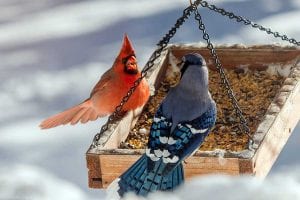Feeding the Birds of Winter
by Peter Gadd
Although seen less frequently in winter, be assured there is a diversity of wild birds in the Miramichi region despite the harsh conditions we often endure. For the last few years the Miramichi Naturalists’ Club through the leadership of member Dave McLeod, has recorded a list of birds observed in Northumberland County from Dec. 1 to the last day of February. During the winter of 2019, 57 species were observed, a low number. The previous winter, 2018, 78 species were observed. The list included ducks, gulls, songbirds, raptors and a group I suppose we could call scavengers that include crows, ravens and pigeons.
Many people enjoy improving the bleak view of winter we often see from our windows by stocking bird feeders in our yards (gardens) to help our avian neighbours get through a cold and barren time. Feeding does improve their chances of survival, however it has been noted through studies that feeder birds still get the majority of their nutritional needs from natural sources such as wild seeds, berries and other fruit and dormant insects in various stages of their life cycle that are hidden in such places as tree bark. They will get by without us. Birds, being warm blooded, need fuel for their metabolic processes to keep the furnace on so to speak. The colder the temperature the greater the amount of activity there will be at the feeders.
One of the most common small feeder birds is of course the Black-capped Chickadee, New Brunswick’s provincial bird. Also seen frequently are Blue Jays. These, along with Dark-eyed Juncos, Goldfinches, Purple Finches, Evening Grosbeaks, the occasional Northern Cardinal, Downy and Hairy Woodpeckers, Red-breasted and White-breasted Nuthatches and Mourning Doves are some of the residential birds living in New Brunswick year round that may come to garden feeders in the winter.
You might also see winter visitors from further north such as American Tree Sparrows, Common Redpolls and Bohemian Waxwings. They visit southern Canada and northern United States for their winter “getaway”. The Bohemian Waxwings don’t usually visit feeders but will in large numbers greedily feast on berries and apples in our yards. In the fall and spring, migrating birds often stop at feeders to re-fuel. Birds such as Fox Sparrows and White Crowned Sparrows and even some other quite rare birds.
It is best to provide a variety of feeder types and a variety of food types. The most popular food is black oil sunflower seeds which are rich in energy. Unsalted peanuts (shelled or not), mixed bird seed, suet, and nyjer seed are other preferred feed types, the latter being very popular with the visiting Siskins and Redpolls. Feed can also just be scattered on the ground as some birds like to scratch and peck. What should be avoided however is bread as it is poor in nutritional value. Feeders should be cleaned from time to time especially after a warm wet spell. Birds also of course need to drink water so if it can be provided in liquid form, it is also a help to them.
For more information about birds in the Miramichi region and the Miramichi Naturalist’s Club visit www.miramichinaturalistclub.com.
Giv’er Miramichi is about “What’s up, what’s new, what’s happening”. We are focused on building people up, supporting one another and celebrating our successes.



